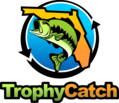 The Florida Fish and Wildlife Conservation Commission's (FWC) TrophyCatch program is going strong in Season 3! TrophyCatch is a citizen-science, conservation rewards program designed for anglers who catch-and-release largemouth bass heavier than eight pounds in Florida. Register at TrophyCatchFlorida.com now to be automatically entered in a free random drawing for a Phoenix bass boat powered by Mercury!
|
Register for a free chance at having this sit in your drive
way!
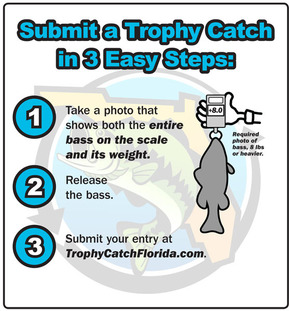 It's easy as 1-2-3 to submit
your catch and earn great rewards from our partners while at the same
time providing data to help determine the future of bass fishing in
Florida. While there, check out the Gallery of Catches, or do a search
to find where trophy bass have been caught near you. Meanwhile, be sure
to “Like” us on Facebook to keep up with the
latest developments.
Program accomplishments to date include:
■ Over 10,000 registrants.
■ More than 2,000 trophy bass over 8 pounds documented and released.
|
■ In addition to contributing to science, anglers that submit a trophy bass receive gift cards and other great prizes from TrophyCatch partners like Bass Pro Shops. |
|
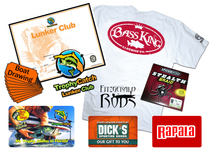 |
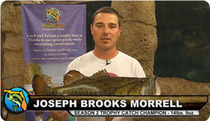 |
|
■ Bob Williams submitted the heaviest TrophyCatch bass in Season 1, at 13 lbs 14 oz. The heaviest bass submitted in Season 2 was Joseph "Brooks" Morrell (in photo) with his 14 lbs 9 oz monster from Lake Kingsley. This fish also earned
him the TrophyCatch Championship Ring from the American Outdoors Fund. Watch the award presentation! |
■ Jill Ganey (in center of photo) was the random drawing winner of the Season 2 Phoenix bass boat! Although TrophyCatch participants receive 10 extra chances in the drawing for every bass they submit, Jill had no submissions -- so any registrant can win. Watch the presentation video! (Still not registered? Sign up now!) |
|
 |
TrophyCatch continues to grow in participants, partners, and prizing. Thank you to everyone who has helped make this conservation program successful. For more information, visit TrophyCatchFlorida.com.

The FWC
favorably reviewed draft rules that could ultimately streamline
statewide length limits for black bass species, including eliminating
many specific rules for different water bodies. The intent of the
proposal is to simplify rules; allow anglers to keep smaller, more
abundant largemouth bass; and increase abundance of larger bass in lakes
and rivers across the state.
FWC
staff heard from nearly 8,000 anglers using a series of open house
meetings and surveys over the past two years. During its June 25 meeting
in Sarasota, Commissioners approved the draft rules and directed staff
to continue discussions with the public prior to final action in
February 2016. Upon approval, these new rules will go into effect on
July 1, 2016.
 In Florida, black bass species include largemouth, shoal, spotted, Suwannee and Choctaw bass. The largemouth bass is the most abundant. It is known worldwide for reaching trophy size.
“These proposed rules were developed with a tremendous amount of public involvement and decades of research on the effectiveness of various regulations,” said Tom Champeau, director of the FWC’s Division of Freshwater Fisheries Management. “We believe this innovative proposal will improve fishing opportunities for our 1.2 million anglers who fish for bass.”
The proposed bass regulations encourage increased angler harvest of smaller largemouth bass while managing for more bass longer than 16 inches. Black bass species found only in rivers in the Florida Panhandle will be managed to conserve populations with limited distributions. While the current statewide daily bag limit of five black bass (all species) will be maintained, the three zones that currently regulate bass harvest would be eliminated along with 42 special regulations for largemouth bass.
|
 Under the new rules, up to
five largemouth bass could be kept of any size with only one 16 inches
or longer in total length per angler per day. For Suwannee, shoal,
Choctaw and spotted basses, the current 12-inch minimum size limit is
maintained, and anglers may keep only one bass 16 inches or longer. In
addition, the proposed changes include a catch-and-release-only zone for
shoal bass in the Chipola River.
FWC
staff advised Commissioners the current bass-tournament permit program
will continue to allow anglers participating in permitted tournaments
temporary possession of five bass of any size. This program has been in
place for over 20 years and allows delayed-release bass tournaments to
take place while ensuring the proper care, handling and release of all
bass caught.
FWC staff
advised Commissioners that public support for the proposed changes was
strong, and Commissioners directed staff to continue public outreach in
anticipation of the July 1, 2016, effective date. Details of the
proposed rule changes and public input can be provided via two surveys.
|
 An ancient Chinese curse states, “May you live in interesting times.” If that’s true, then anyone reading this in 2015 is very well cursed, indeed. We live in an era where people casually walk the streets with more advanced technology in their pockets than our nation sent to the moon back in 1969. A person can hold in their palm more processing power than room-sized computers used to be able to generate. I’m speaking, of course, of modern “smartphones.” These amazing gadgets aren’t just for talking any more, and with increased capabilities and added features can do some amazing things. But the really important question is, can smartphones put more fish on the line? I’m here to tell you that the answer is “Yes!”
But first, it’s time for “Smartphones 101.” Loosely defined, a smartphone is a cell phone that has added capabilities, essentially the marriage of a cell phone to a camera, GPS, and PDA (personal digital assistant). Currently, several of the most popular smartphone platforms are iPhone, Android and Windows 7/Mobile, although there are others as well. Features and capabilities vary widely, as do the various cell phone service providers and the hardware and service plans they offer. We won’t go there, but be aware that in addition to basic cell phone service, you’ll also need to sign up for a data plan if you want to take full advantage of all of your smartphone’s capabilities. The last thing you need to know is that these smartphones are essentially miniature computers, and just like computers they can run a wide variety of programs. These programs are called applications, or apps for short. Certain apps may only be available for certain platforms, but many of the most popular apps have very wide compatibility. The good news is that apps are dirt cheap compared to computer programs, usually only costing a few dollars apiece.
|
 Now on to the good stuff! There are a number of smartphone features we’ll be discussing, but one of the most helpful for me has been the built in GPS with mapping. Whether you’re trying to find the boat ramp, a tackle shop, or your secret fishin’ hole, you almost always have mapping capabilities with you as long as you have your smartphone and a good signal.
Here’s a recent example: An angling buddy and I were fishing a series of short canals along a major urban road in southeast Florida. We also planned to hit a nearby lake tucked away behind some buildings, which we soon realized wasn’t visible from the canals. When we began to suspect we might have overshot the lake, I whipped out my phone and discovered that, sure enough, it was behind the buildings adjacent to the last stretch of canal we’d just fished. I figure my phone saved us at least ten minutes’ scouting time, and that’s assuming we started off in the right direction.
I’ve also found the phone quite handy for navigating my way around the many little canals and lakes in the areas I fish—more than I can easily keep track of by memory. Most mapping systems feature several views: standard (roads), satellite (topographic, similar to Google Earth satellite photos), and hybrid (both, with roads as well as natural features shown). I’ll switch to standard when I’m driving, and to satellite or hybrid when I’m actually on the water. You can even buy car brackets that will let you mount your phone on the dash or window or boat, just like a regular car GPS. My cell phone allows me to take screenshots, just like a computer, and I’ve used this feature to record photos showing important map locations on some of the waters I fish.
|
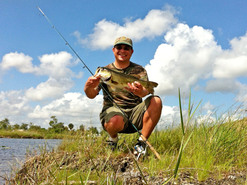 One of the handiest gizmos included in smartphones is the camera. I’ve now got a pretty decent point-and-shoot camera with me wherever I go, without the need to remember to throw one in my tackle pack when I head out the door. I’ve gotten some great pictures in situations I never would have brought a camera to, and am always ready to snap a shot of “the big one,” no matter where or when he bites. Some phones have excellent cameras with outstanding exposure control built in, suitable for magazine quality picture-taking. There are various methods and accessories for taking "selfies" (self portraits) of you and your fish.
And while I do most of my digital photo editing on my computer, there’s a dizzying array of apps that will let you edit, modify, or add captions or other graphics to photos right on your phone before messaging them off to jealous fishing buddies, right from boat or shore. It’s great not having to wait until after you get home and park the boat to share your great catch with a friend or family member.
So-called “E-tournaments” are beginning to use smartphone technology so that an angler can photograph his fish right on the water, release it almost immediately, and then multimedia message his photos to the tournament coordinator for entry. One of the really nice features of phones with built in GPS is coordinate tagging of the photos you take. On my computer (or with yet another app installed on my phone), I can open a picture of a bass and then see where I caught it on a map as well as the date—pretty handy for keeping track of the where and when of all those fishing trips.
These are just a few of the ways that smartphones can help put more fish on the line. Stay tuned for Part 2 in the next issue!
|
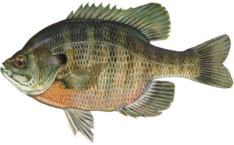 Size: This is one of the smallest of our popular sportfish. The state record is 2.95 pounds. The Big Catch minimum qualifying sizes are 10” or 1.0 pound (see BigCatchFlorida.com).
Identification: The bluegill is easily identified by the black spot on the gill cover and black spot on the end of the dorsal fin.
Similar species: The similar redear sunfish, as its name suggests, has a bright red border on the edge of the gill cover. The redear, along with other sunfish, lacks the bluegill's black dorsal fin spot.
Angling qualities: This willing fish is probably the best “starter” species of all for beginners, but will also continue to entertain anglers of any age or experience level. It will cooperatively and enthusiastically take worms, crickets, grass shrimp, cut hot dogs, and doughballs. It will also attack any suitably small lure with abandon—recommended choices include beetle spins, jigs, spinners, tiny minnow imitations, small spoons, and most flies. Even a good-sized bluegill has a very small mouth, so always stick with small hook and lure sizes. While this fish rarely jumps, it puts up a very scrappy fight for its size, especially on ultralight tackle. Food quality is excellent, especially in the frying pan.
|
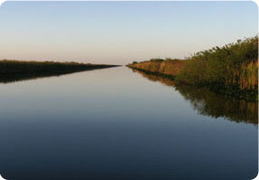 Size: 1,125 square miles.
Location: Palm Beach, Broward and Miami-Dade counties.
Description: Water Conservation Areas (WCA) 2 and 3 are two sections of northern Everglades habitat that are managed for multiple uses. Note that health advisories related to consumption of fish, especially bass, gar and bowfin are in effect for the area. The WCAs were designated primarily to receive flood waters from adjacent areas and store them for beneficial municipal, urban, and agricultural uses. Both areas have continually provided superior fishing throughout the years. Largemouth bass is the most sought after species, and when waters levels are right, provide anglers with some of the highest catch rates in the state. Other popular species readily caught include bluegill, redear sunfish, pickerel, oscar, and Mayan cichlid. The majority of fishing pressure takes place during the winter and spring months when water levels are typically dropping, which concentrates fish into the perimeter canals. When water levels are up, anglers have access to vast marsh systems for a different type of angling experience.
|
Low water levels tend to push fish out of the marsh and concentrate them in the bordering canals. Recent analyses of historical data indicate that the larger and faster the drop in water level, the stronger the "push" of fish into the canals. |
|
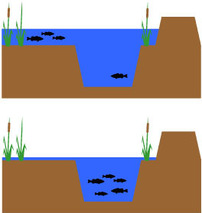 |
Water Conservation Area 2 encompasses 210 square miles and is located in western Palm Beach and Broward counties. The majority of fishing takes place within the L-35B and L-38E canals which are each approximately 12 miles long. Main access for this area is the Sawgrass Recreation Area, located two miles north of Alligator Alley (SR84) on U.S. 27. Current fishing information, as well as a guide service, camping, food, boat rental, fishing licenses, and bait and tackle can be found there (954-389-0202).
The 915 square mile WCA-3 is located in western Broward and Miami-Dade counties, just south of WCA-2 and north of Everglades National Park. Many miles of canals run around and through the area, including the L-67A, L-67C, Miami, and Tamiami canals. Many of the canals can be accessed at Holiday Park Recreation Area (954-434-8111). Amenities there include fishing guides, boat rentals, food, bait and tackle and the sale of fishing licenses.
Check our Fishing Forecast page and Water Conservation Area Brochure for more information.
This newsletter got its start as a regional freshwater fishing periodical, The City Fisher, in heavily urbanized southeast Florida. Back issues are available. To contact the Florida Freshwater Angler, email John Cimbaro.
|